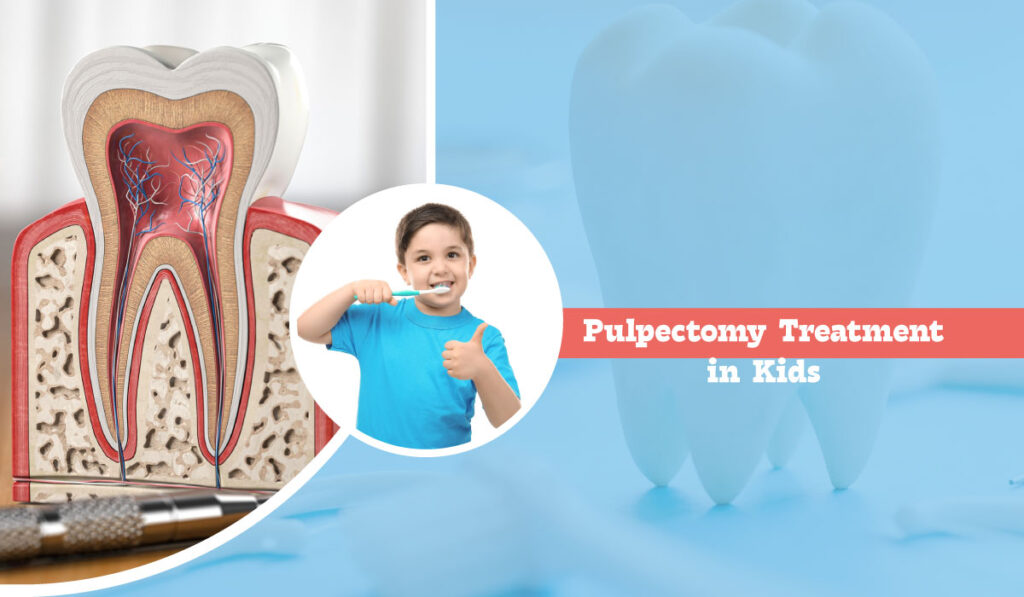When the tooth of the child is severely decayed or infected, it is advisable to keep the tooth instead of removing it. Pedodontic pulpotomy and pulpectomy are then options in this case. Parents become confused about what pediatric pulpotomy and pulpectomy are and what their child will need. Both are procedures to save the tooth but are different in procedure and objective. In this blog, we’ll explain each procedure, when they are used, their success rates, and how parents can help with aftercare.
What Is a Pulpotomy?
A pulpotomy is a common dental procedure performed on baby teeth when the decay has reached the pulp chamber but hasn’t infected the roots. With this type of treatment, the infected pulp portion of the pulp within the crown is removed by the dentist without handling the root pulp. This will allow the natural tooth to be left intact for chewing and speech.
Key points about pulpotomy:
- Used when infection is limited to the crown portion.
- Quick and minimally invasive.
- Often followed by a stainless steel crown for protection.
What Is a Pulpectomy?
Unlike pulpotomy, pulpectomy entails the removal of all pulp tissues, including the roots, as the infection has penetrated deeper. The dentist then cleans and shapes the canals before filling them with child-friendly material.
Why is it Done?
- For extremely decayed or infected teeth.
- To avoid premature loss of the tooth, which can affect the bite and the alignment.
Understanding the difference between pediatric pulpotomy and pulpectomy educates parents as to why the dentist would employ one technique over another.
When to Perform Full Root Canal on Primary Tooth?
Parents often wonder, “When is a full root canal necessary for a baby tooth?” A pulpectomy works like a root canal for primary teeth and is performed when infection has reached the roots. This is where expert care matters; practices offering pediatric dentistry in Santa Clarita have the experience to handle these delicate treatments safely and effectively.
- Infection extends to the root canals.
- There’s an abscess or pus formation.
- The tooth is crucial for space maintenance until the permanent tooth erupts.
Early intervention prevents pain, swelling, and damage to developing permanent teeth.
Role of Restorative Dentistry for Kids Near You
Once a pulpectomy or a pulpotomy has been done, the strength of the tooth should be regained. Procedures that offer restorative dentistry for children in your local area offer fillings and crowns that shield and protect the healed tooth until it will eventually be lost. That is very important to help maintain the chewing function, avoid speech problems, and avoid orthodontic problems later on.
Long-Term Success Rates of Baby Tooth Pulpotomy
Research shows pulpotomies have success rates of 85–95% when performed early and followed by proper restoration. Success depends on the medicaments used and regular follow-ups with the dentist.
Materials Used in Pulpotomy Medicament for Children
The medicaments used during pulpotomy ensure the remaining pulp stays healthy. Common materials include:
- Formocresol – Traditional option, effective but used cautiously.
- MTA (Mineral Trioxide Aggregate) – Highly biocompatible and preferred for long-term results.
- Ferric Sulfate – Helps control bleeding and maintain pulp vitality.
The choice of material affects healing and success rates, making it important to trust an experienced pediatric dentist.
Post-Op Care After Pulpectomy in Pediatric Patients
Following a pulpectomy, proper aftercare eliminates complications. Parents should:
- Give the child soft foods for several days without exerting any pressure on the tooth.
- Practice oral hygiene but brush gently around the treated tooth.
- Monitor for swelling, pain, or fever and report to the dentist at once if any are observed.
This ensures a good recovery and avoids reinfection.
Comparison: Pulpotomy vs Pulpectomy
| Comparison Point | Pulpotomy | Pulpectomy |
| Infection Level | Limited to crown pulp | Affects crown and root pulp |
| Invasiveness | Less invasive | More invasive |
| Treatment Goal | Preserve tooth vitality | Remove all infected tissue |
| Restoration Needed | Yes, usually crown | Yes, crown or filling |
Give Your Little One a Lifetime of Healthy Smiles; Visit Today!
Don’t let cavities ruin your child’s smile and the development of his or her mouth. Treatment early on avoids pain and saves them from future dental issues. Schedule an appointment today with SCV Pediatric Dentistry & Orthodontics for professional pulpotomy, pulpectomy, and all of your child’s dental needs.
FAQs
- Is pulpotomy painful for children?
No, it is performed under local anesthesia, and children are comfortable throughout the procedure.
- How long does it take for a pulpectomy?
It usually takes 30–60 minutes, depending on the tooth and the level of the infection.
- Are these treatments able to save all primary teeth?
Not always. Severely broken-down teeth might need to be removed if they cannot be safely restored.
- Are these treatments safe for children?
Yes, they are safe and routine if performed by a pediatric dentist.
- How do I know if my child needs these procedures?
Watch for signs such as a poor toothache, swelling, or pus around the tooth. A pediatric dentist will verify with an X-ray.

